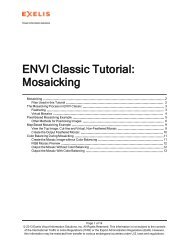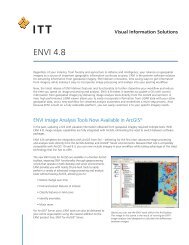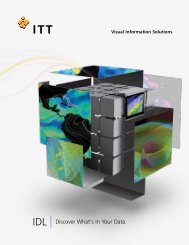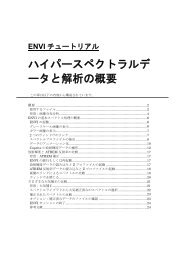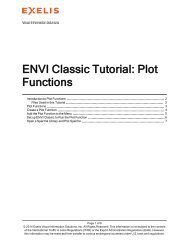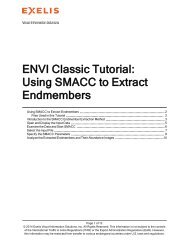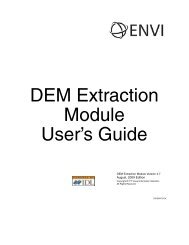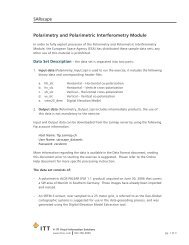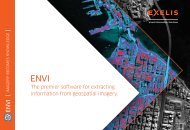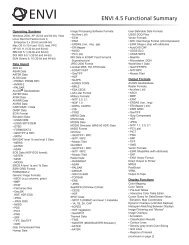SARscape Interferometry Module for Displacement Map Generation
SARscape Interferometry Module for Displacement Map Generation
SARscape Interferometry Module for Displacement Map Generation
You also want an ePaper? Increase the reach of your titles
YUMPU automatically turns print PDFs into web optimized ePapers that Google loves.
<strong>SARscape</strong><strong>Interferometry</strong> <strong>Module</strong> <strong>for</strong> <strong>Displacement</strong> <strong>Map</strong> <strong>Generation</strong>In order to fully exploit processes of the <strong>Interferometry</strong> <strong>Module</strong> <strong>for</strong> <strong>Displacement</strong> <strong>Map</strong><strong>Generation</strong>, the European Space Agency (ESA) has distributed these sample data sets;any other use of this material is prohibited.Data Set Description – the data set is separated into two parts:1. Input (Bam_DInSAR_Input.zip) is used to run the exercise, it includes the followingbinary data and corresponding header file:a. 3dec03_slc Master SLC datab. 11feb04_slc Slave SLC datac. srtm25_dem Reference Digital Elevation Model2. Output data (Bam_DInSAR_Output.zip) includes intermediate products and a possibleset of Ground Control Points that could be used in the Phase to <strong>Displacement</strong> Conversionstep, the use of these data are not mandatory to the exercise.Input and Output data can be downloaded from the sarmap server by using the followingftp account in<strong>for</strong>mation.Host Name: ftp.sarmap.chUser Name: sarscape_datasetsPassword: zxcvbnmMore in<strong>for</strong>mation regarding the data is available in the Data Format document, readingthis document prior to starting the exercise is suggested. Please refer to the OnlineHelp document <strong>for</strong> more specific processing instruction.The data consists of:– An ENVISAT ASAR Single Look Complex data pair acquired in the IS2 mode, withthe SAR incidence angle of approximately 23°, and VV polarization over Bam, Iran.The satellite acquisition dates are December 3, 2003 (be<strong>for</strong>e the earthquake) andFebruary 11, 2004 (47 days after the earthquake). The images provided <strong>for</strong> thisexercise have already been imported (using the verified DORIS satellite orbits) andresized. The area coverage is approximately 56x40km.© ITT Visual In<strong>for</strong>mation Solutionswww.ittvis.com 303-786-9900pg. 1 of 4
<strong>SARscape</strong>– An SRTM-3 extract, over sampled to a 25 meter grid, is used as reference to thelow resolution Digital Elevation Model, and was generated using the Digital ElevationModel Extraction tool.The goals of this exercise are:• To estimate the orbital related parameters.• To generate the interferogram.• To flatten the interferogram and separate the differential phase through thereference Digital Elevation Model.• To filter the flattened interferogram and to generate the coherence image.• To unwrap the differential phase.• To generate the DInSAR <strong>Displacement</strong> <strong>Map</strong>.Processing StepsBaseline EstimationEnables the user to obtain infomraiton about the baseline values and other orbitalparameters of the input SAR pair. This function is not mandatory to the exercise.Interferogram <strong>Generation</strong>Starting with the two Single Look Complex input data, co-registered, and multi-lookinginterferogram, the master Intensity and slave Intensity images are generated. In orderto get a quasi-square pixel around 25m (on the ground), using multi-looking factors of1 in range and 5 in azimuth are suggested. The products are automatically named byadding the relevant suffix to the output file names.If the Digital Elevation Model is used in input (optional), the flattened interferogram(_dint), the slant range DEM (_srdem) and the synthetic interferogram (_sint) will begenerated among the output products. In this case, the Interferogram Flattening stephas not been carried out and the Adaptive Filter and Coherence <strong>Generation</strong> step willfollow in the processing sequence.Digital Elevation Model/Ellipsoid Interferogram FlatteningDuring this processing the previously generated interferogram is split into the syntheticphase and the residual phase (or differential phase). Then the input Digital ElevationModel is re-projected onto the master SAR geometry and is re-generated as a slantrange output product. The output products are automatically named by adding therelevant suffix to the root name.© ITT Visual In<strong>for</strong>mation Solutionswww.ittvis.com 303-786-9900pg. 2 of 4
<strong>SARscape</strong>Notes:- Look Up Table related problems can be experienced when displaying the data in theENVI view. The problem is solved by properly stretching the image histogram usingthe relevant function from the “Enhance” pull down menu of the ENVI image window.- Tiff files are intended only <strong>for</strong> visualization, the original histogram is stretched to8 bit by means of a pre-defined scaling <strong>for</strong>mula (see “Tools>GenerateTiff”).- The interferograms are shown in grey scale; in order to visualize the interferometricfringes in RGB the corresponding tiff file must be created.- The .sml and .hdr are the product header files, the .sml contains all the processingrelated in<strong>for</strong>mation and the .hdr contains the in<strong>for</strong>mation <strong>for</strong> product compatibilitywith ENVI.- It does not matter which of the input data are selected as master and which isslave, it is mandatory that the initial order is maintained throughout the entireprocessing chain.© ITT Visual In<strong>for</strong>mation Solutionswww.ittvis.com 303-786-9900pg. 4 of 4



